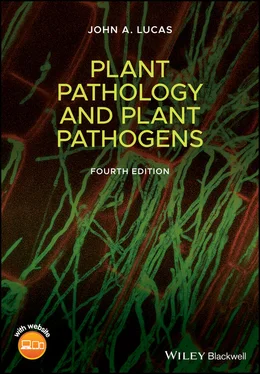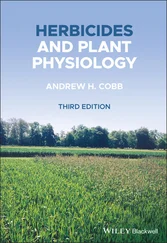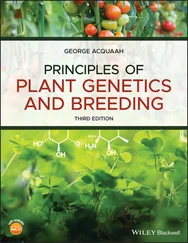Plant pathogens can also have major impacts on both natural and managed forests. Currently, sudden oak death is spreading in the western USA and Europe, while ash dieback has recently invaded the UK. With the expansion of international trade in plants and plant products, the frequency of invasions by exotic pests and pathogens is increasing, with serious implications for many native plant species (see Chapter 5).
Quantifying Losses Due to Disease
Even in areas of high agricultural efficiency, losses due to pathogens, pests, and weeds make constant inroads into production, and hence profits. Such estimates are notoriously difficult to compile but suggest that as much as one‐third of total production is being lost. Table 1.6shows estimated worldwide losses for six major crops due to weeds, pests, pathogens, and virus diseases during 2001–2003. Furthermore, comparison with data from earlier surveys ( Figure 1.9) suggests that the situation has not improved in recent years, despite advances in the science and practice of crop protection. Some of the changes taking place in modern agriculture may in fact have increased vulnerability to disease. The demand for improved agricultural productivity has led to large areas being planted with high‐yielding, genetically identical cultivars. Similarly, the increasing cost of labour and the trend toward mechanization, which involves major capital expenditure, have also contributed to a reduction in the diversity of crop types planted. As a result, long‐established systems of crop rotation have been discontinued in many areas.
Table 1.6 Estimated losses (%) due to weeds, pests, and diseases in six major crops worldwide in 2001–2003
Source: Oerke (2006).
| Crop |
Weeds |
Pests |
Pathogens |
Viruses |
Total |
| Wheat |
7.7 |
7.9 |
10.2 |
2.4 |
28.2 |
| Rice |
10.2 |
15.1 |
10.8 |
1.4 |
37.4 |
| Maize |
10.5 |
9.6 |
8.5 |
2.7 |
31.2 |
| Potatoes |
8.3 |
10.9 |
14.5 |
6.6 |
40.3 |
| Soybeans |
7.5 |
8.8 |
8.9 |
1.2 |
26.3 |
| Cotton |
8.6 |
12.3 |
7.2 |
0.7 |
28.8 |
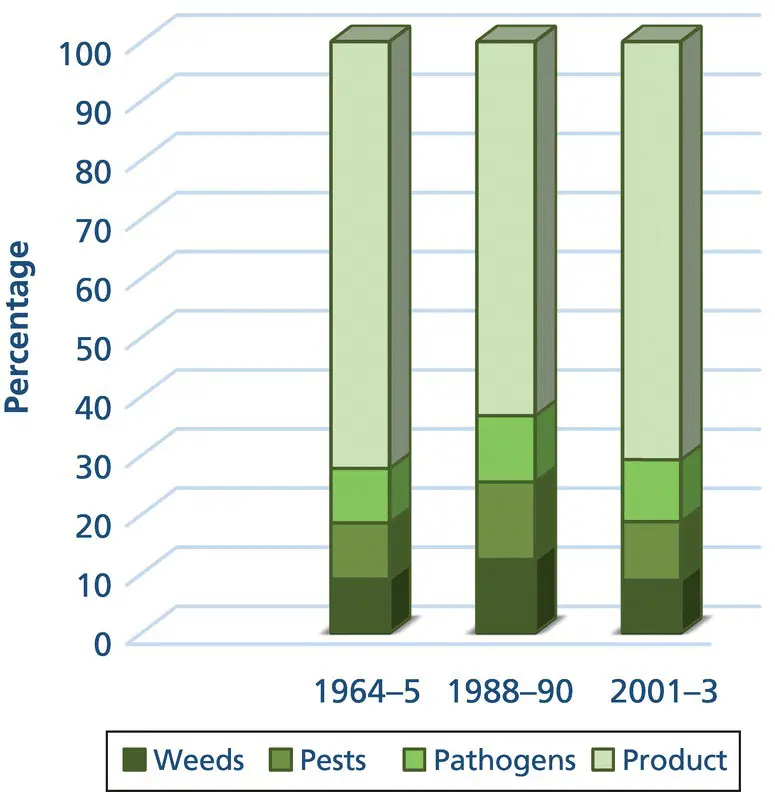
Figure 1.9 Comparison of proportions of total production of major food and cash crops lost to pathogens, pests and weeds estimated in 1964–1965 (by Cramer, 1967), and 1988–1990 and 2001–2003 (by Oerke et al. 1994; Oerke 2006). Note: Crops included in the calculation are not identical in the three surveys.
A second aspect of modern agriculture which has undoubtedly aggravated disease problems is increased world trade in crop plants and plant products. Following the gradual shift from self‐sufficiency, at a community and in many instances also at a national level, and the increasing relative affluence of some countries, large‐scale transport of plant material and food produce over long distances has become commonplace. One consequence of this globalization of plant trade is the increased risk of introducing invasive pests and pathogens (see discussion of new‐encounter diseases earlier). In addition, there is increasing long‐term storage of produce, which in turn brings further pathological problems. Losses due to postharvest pests and diseases such as storage rots have tended to be underrated. It has been estimated that a significant proportion of all tropical produce may be destroyed, by a variety of agents, before it reaches the consumer. Even in developed countries, the scale of potential losses during long‐term storage, transport, and marketing can be surprisingly high ( Table 1.7). Overall, such losses are due to a range of factors, including not only biotic agents but also waste during processing, handling and by consumers. In developed countries, extensive refrigeration systems, more effective handling of produce and other control measures have now reduced the impact of postharvest pests and diseases. Nonetheless, more recent estimates of food losses indicate that substantial amounts of some commodities still go to waste. For instance, the combined loss of grain products, fresh fruit, and vegetables during retail and by consumers in the USA is between 20% and 40%. Consumer intolerance of substandard produce has placed a greater emphasis on food quality so, for instance, blemished or misshapen fruit and vegetables will often be rejected. Hence, pests or diseases causing superficial damage have assumed greater importance.
Table 1.7 Estimates of postharvest losses likely to occur in the absence of effective disease control measures
Source: Data from Eckert (1977).
|
Commodity |
Country of origin |
Potential loss (%) |
| Loss during low‐temperature storage |
Apples |
England, USA |
2–50 |
| Carrots |
England, USA |
6–38 |
| Citrus fruits |
Italy, USA |
3–52 |
| Loss during transport and marketing |
Apples |
USA |
29 |
| Citrus fruits |
USA |
0–25 |
| Lettuce |
USA |
10–15 |
| Peaches |
USA |
15–24 |
| Strawberries |
USA |
25–35 |
Disease is a Dynamic Phenomenon
The intensification of agriculture through plant breeding, widespread use of fertilizers, pesticides and plant growth regulators, with larger fields and shorter rotations, has brought in its wake new and sometimes severe disease problems. Changes in the types of crops grown, or in crop management practices, almost invariably lead to new challenges. Irrigation has opened up whole regions to agriculture, but the same water which brings life to the crop can also nourish and spread its microbial enemies. The extension of crops into new geographical areas has exposed them to novel disease agents; for instance, tropical plant species such as cocoa and cassava, which originated in South America, are grown extensively in Africa where they have succumbed to virus diseases spreading from native species. While breeding programs and chemical control measures have won notable victories in the campaign against plant disease, the situation is never static. If anything, in recent years the threat posed by pests and pathogens has increased, rather than decreased ( Figure 1.10).
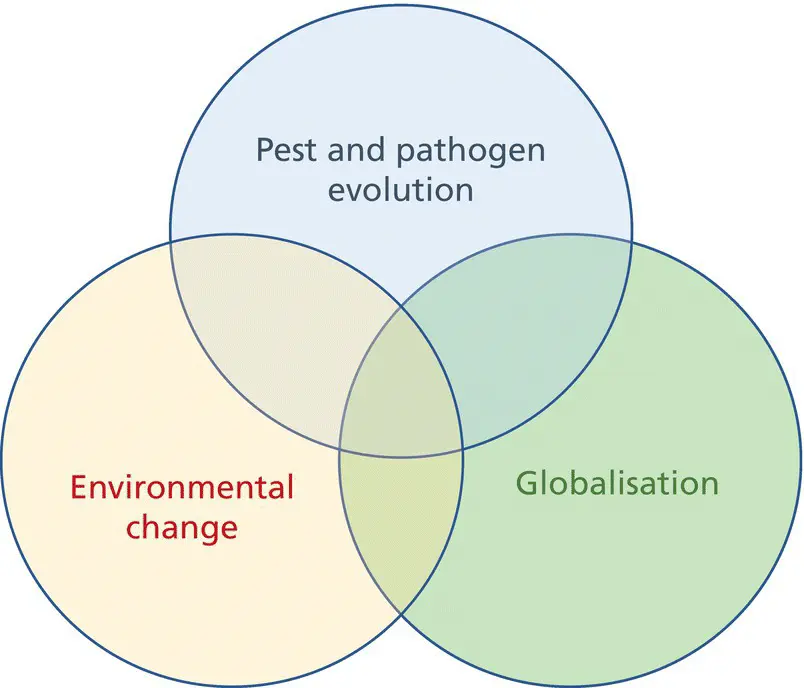
Figure 1.10 A convergence of forces increasing the threat of plant disease.
Source: Lucas (2017b).
The age we are living in has been described as the “Anthropocene,” as no part of the planet is now unaffected by human activity. Environmental change has taken place on a massive scale, altering ecosystems, modifying the distribution of species, and reducing biodiversity. The globalization of trade and travel has redistributed crops and plant products and inadvertently introduced their enemies into new regions. There is now conclusive evidence that the global climate is changing as a result of human actions. Altogether, the pace of such change is accelerating the adaptation and evolution of biological systems, including the pathogens causing animal and plant diseases. There is a need therefore for constant vigilance to ensure that the plants we grow remain healthy and productive.
Читать дальше
